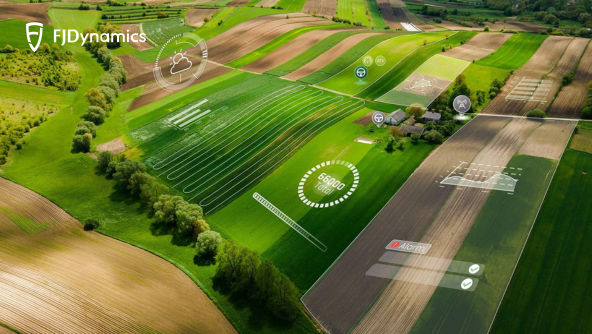In 2025, new agriculture technology is transforming the way farmers operate. Whether you’re facing climate challenges or working to improve food security, these innovations offer solutions that help you grow smarter, cut waste, and protect the environment. Imagine using IoT devices to monitor your crops in real time, AI to predict the best planting times, and autonomous machinery to handle labor-intensive tasks efficiently.Let’s dive into the top trends in agriculture and see how they can make a real difference on your farm.

1. IoT Devices Revolutionizing Crop Management
Imagine having real-time updates on your soil’s moisture levels or a forecast of a sudden weather change delivered straight to your phone. IoT devices for crop management make it possible by offering insights that help you make smarter decisions (ScienceDirect on IoT in Agriculture).
How it works:IoT sensors like those from Arable and Semios track soil health, weather, and crop conditions. Platforms like the FJDynamics Farm Management System integrate this data, allowing you to optimize irrigation, reduce water usage, and apply fertilizers precisely where needed.

Key Benefits:
- Water Savings: Avoid overwatering and conserve resources.
- Targeted Inputs: Minimize waste by applying fertilizers only where necessary.
- Improved Yields: Maintain healthier crops with accurate data.
2. AI for Sustainable Farming
AI for sustainable farming is revolutionizing agriculture by turning data into actionable insights. Whether it’s predicting pest outbreaks or suggesting the optimal planting time, AI helps you make proactive decisions.
Real-world Applications:In California, almond farmers using AI tools like Semios reduced pest damage by over 50%, cutting pesticide costs and protecting the environment. AI systems analyze satellite imagery, weather data, and crop health to deliver precise recommendations.
Key Benefits:
- Proactive Pest Control: Address issues before they escalate.
- Efficient Resource Use: Reduce chemical inputs without compromising productivity.
- Labor Savings: Automate routine monitoring and tasks.
3. Data Analytics in Agriculture
Farming has evolved into a data-driven industry. Data analytics in agriculture helps uncover patterns and optimize every aspect of farming, from planting to harvesting.
How It Works:By collecting data from IoT sensors, drones, and satellites, platforms like theFJDynamics Farm Management System provide actionable insights for:
- Yield Forecasting: Plan better with accurate production predictions.
- Input Optimization: Minimize waste by focusing on high-need areas.
- Early Problem Detection: Spot issues like water shortages before they escalate.
4. Autonomous Farm Equipment
The labor-intensive nature of farming is getting a major upgrade with autonomous farm equipment. These machines handle tasks like plowing, planting, and harvesting with minimal supervision.
Examples:
- Self-driving Tractors: Equipped with GPS and sensors for precise operations.
- Robotic Harvesters: AI-powered systems that pick ripe produce efficiently, reducing waste.
- Labor Efficiency: Address labor shortages with automation.
- Precision Farming: Reduce input waste by targeting specific areas.
- Cost Savings: Lower operational costs by cutting fuel and labor expenses.
5. Advanced Biotechnology and Smart Irrigation Systems
Biotechnology for Better Crops
Biotechnology is enhancing crop resilience by developing seeds that thrive in harsh conditions. Drought-resistant, pest-tolerant, and high-yield seeds are helping farmers grow more food with fewer resources.Why It Matters:
- Reduced Chemical Use: Minimize reliance on fertilizers and pesticides.
- Higher Productivity: Achieve better yields in extreme climates.
- Sustainability: Improve food security while protecting the environment.
Smart Irrigation Systems
Efficient water use is critical for sustainable farming. Smart irrigation systems use IoT sensors to deliver water exactly when and where it’s needed ( Irrigation Association on Smart Irrigation), reducing waste and ensuring optimal crop hydration.Key Benefits:
- Water Conservation: Save up to 30% more water compared to traditional methods.
- Energy Efficiency: Lower energy consumption with solar-powered pumps.
- Improved Yields: Ensure consistent growth with precise irrigation.
6. Blockchain for Supply Chain Transparency
Blockchain technology is transforming agriculture by ensuring complete transparency in the supply chain. Farmers, distributors, and consumers can access reliable, real-time information about food origins and quality.
How It Helps:
- Builds Trust: Consumers know exactly where their food comes from.
- Reduces Fraud: Prevents counterfeit or mislabeled products.
- Streamlines Operations: Speeds up transactions and reduces costs.
7. Digital Twins in Farming
Digital twins create virtual replicas of farms, allowing you to simulate and monitor operations in real time. This technology provides predictive insights, helping you test strategies like irrigation adjustments or pest control measures before implementing them in the field.
Key Benefits:
- Risk Reduction: Identify and address potential issues before they escalate.
- Enhanced Decision-making: Use simulations to choose the best farming practices.
- Resource Optimization: Minimize waste and maximize efficiency.
Real-World Applications: FJD Farm Management System
The FJD Farm Management System is transforming agriculture by integrating cutting-edge technology into farm operations. Here’s how it helps:
- Telemetry: Connect machinery for real-time monitoring and optimization.
- Precision Mapping: Enhance yields by applying inputs to targeted areas.
- Subsidy Management: Simplify the process of claiming agricultural subsidies.
Take the First Step
The future of farming has never been more promising. New agriculture technology offers you the tools to overcome challenges and secure a sustainable future. With innovations like IoT devices delivering real-time data, AI systems offering predictive insights, and autonomous machinery automating labor-intensive tasks, your farm can achieve unparalleled efficiency and profitability.By adopting these cutting-edge technologies, you can:
- Enhance Efficiency: Streamline your operations and minimize resource waste.
- Minimize Environmental Impact: Implement sustainable practices that protect the planet.
- Increase Yields and Profits: Leverage smart tools to boost productivity and profitability.
FAQs on New Agriculture Technology
What is new agriculture technology?
It includes IoT devices, AI, and autonomous machinery that enhance farming efficiency and sustainability. Learn more about new agriculture technology innovations (USDA on Farming Innovations).
How do IoT devices help in farming?
They provide real-time data on soil and crop conditions, helping you optimize resource use.
How does data analytics transform farming?
By uncovering trends and optimizing inputs, data analytics improves yields and cuts costs.